REVEALED: The forgotten first match between a VFL team and an Aboriginal football team
On Tuesday, September 16, 1913, something occurred that should be commemorated within the annals of Australian Rules football, but has instead been completely forgotten. The first ever match between a VFL team and an Aboriginal team.
The match was an accident of history. After missing the finals for the first time since 1903, the Carlton Football Club made plans to visit Sydney for their post-season trip. According to The Australasian, “owing to a small-pox outbreak still flourishing in the sister capital. It has been decided to give the players a trip to the Gippsland Lakes instead, under the control of Mr. T. F. Cooke.”
Punch, informed their Melbourne readers that the holiday “took in beauty spots of Cunninghame and Lake Tyers. All unite in saying that there is more pleasure in such a trip than in fighting in the finals.”
And it was during this trip in the East Gippsland town of Cuninnghame aka Cuninghame (now known as Lakes Entrance) that Carlton would play the Aboriginal Station team of Lake Tyers.
But apart from this satire there was nothing else in Melbourne’s newspapers. Nothing about this curious match. It lay forgotten, abandoned by history. And if not for this report by “Mercury” in the Maffra Spectator, the game might have been lost forever.
The colonial archive is crucial when documenting the achievements of early Aboriginal football teams and players. Put bluntly, it is a history recorded by colonists replete with the disturbing prejudice, ignorance and lazy misconceptions. But without it, the vital history of early Aboriginal football would be impossible to document.
FOOTBALL. WHITE VERSUS BLACK.
A match was played on Tuesday of last week at Cuninghame by Carlton against an 18 of Lake Tyers aborigines. In order to play, the latter had to travel by foot from the station, nearly 10 miles distant, and return the same day – also per foot. This probably constitutes a record in enthusiasm for a match, and the gins, with piccaninnies in their arms, came in large numbers to witness the contest. The blacks wore light-blue guernseys with gold sashes, and a few had white knickers this being a further indication of their love for the Australian national game, since those uniforms were purchased by themselves out of very meagre allowance. This being the first time the natives had been honored by a game against a League team, great excitement prevailed, the gins being most enthusiastic, frequent cries from them of “Well done Norman,” “Played Gordon,” “Buck in Harold,” “Well played Lawrence,” showing their appreciation, as well and the blacks’ fancy for high class Christian names. The natives started off wearing boots, which, being without studs, were soon discarded; and proved that they had a good knowledge of the finer points of the game, their pace, marking, hand-passing and kicking being at times fine; whilst they played with combination. Their imitative faculties will cause this game to be of educative value to them, but lack of weight as a team will always be their drawback. Whilst the gins exhibited a thorough knowledge of the game, which they followed with keen interest and complimentary references to good play, less elegant expressions of contempt showed that the blacks have assimilated all the worst points of the white barracker also. After the match the Carlton manager presented the team with the ball to carry back with them to the station, also supplying the company with provisions to speed them on their long, and at this stage, weary journey. Just prior to the game one of the blacks was arrested, charged with a technical offence, but the good offices of the Carlton team subsequently secured his release on bail. – “Mercury” Maffra Spectator, September 25, 1913.
The imagery is powerful. One of the wealthiest, most powerful teams of the Victorian football establishment meeting on a playing field a team representing a marginalised, impoverished community. Sport as the ultimate leveller.
We have already established the fact that this match taking place was, in itself, remarkable. But matches like this one weren’t supposed to happen.
By 1913, matches between indigenous teams representing Aboriginal Station teams (Coranderrk, Cummeragunja, Lake Tyers, Framlingham) and local white teams were a common occurrence. What was uncommon, almost non-existent, were matches against top flight teams from Melbourne; home and away and for decades to come. Requests from the secretaries of Aboriginal Station teams were turned down and ignored. The combined efforts of Aboriginal Station managers, the Board for the Protection of Aborigines, the Victorian Football League and Victorian Football Association erected barriers for Indigenous teams, and players, to enter the charmed circle that was the birthplace of Australian Rules football.
The development of Aboriginal Station football teams followed fairly similar trajectories. In the late 19th century Australian Rules football teams and competitions had sprung up all over regional Victoria and Southern NSW. Local teams needing to make up numbers and boost the talent of their playing stocks selected Aboriginal players in their squads. For example, talented players like Dick Rowan and Bobby Wandin would come up against each other when they represented Lilydale and Healesville.
In June 1892, Dick Rowan appeared for South Melbourne in a friendly match against Williamstown. The Sportsman reported, “Rowan, an aboriginal from the Coranderrk Station, played with the South Melbourne on Saturday. His kicking was first-class, but he kept clear of scrimmages.”
In May 1893, The Argus reported that at a meeting of the Board for the Protection of Aborigines, “An aboriginal from Coranderrk applied for permission to play football at South Melbourne during the coming season, but the board feared that the granting of the application might lead to numerous other similar requests, and refused it.”
If not for the mean, paternalistic, colonial bureaucracy that had curtailed his football career, Dick Rowan could have blazed a trail for other Indigenous players.
By this time the pre-colonial Aboriginal population in Victoria had been decimated. In 1886, the Victorian government introduced the “half-caste act” as a way to forcibly ‘integrate’ half-caste Aboriginals into the general population. Every “half-caste” Aboriginal under the age of 35 had to leave the Aboriginal station. Despite their exiguous numbers, Aboriginal stations, with populations of less than 100 like Coranderrk and Lake Tyers, were able to form clubs with help of “half castes” who lived near the station. Quite quickly, they established themselves as teams to be reckoned with in local competitions. However, trying to organise matches with teams from Melbourne proved much more problematic.
A match between a visiting Aboriginal team and a Melbourne side was sabotaged in 1900 when the station manager allowed only two of the residents of the Coranderrk Aboriginal Station to travel to Melbourne to participate in a charity match against a team representing Coburg. The promoter of the match then made up for the shortfall in Aboriginal players by getting six of his friends to “black up” in one of the strangest games of football ever played.
Also in 1900, Cummeragunja became the talk of regional Victoria after they shocked White Australia by defeating South Bendigo, the reigning premiers of Bendigo Football League not once, but twice. The following year, they drew a bigger crowd in Ballarat in their match against the Ballarat Association than the visit of a star studded combined VFL team a fortnight later. Plans were made for Cummeragunja to play the Geelong VFL team, in what would have been the first VFL team versus Aboriginal team match, but it did not eventuate.
At a meeting of the VFL on July 24, 1908, The Argus reported that “in a letter from Mr. T. Wilson Smith, secretary of the Lake Tyers Aboriginal Football Club, the League was invited to enter into negotiations for a visit to Melbourne, by a team of aborigines, to play matches against good metropolitan teams. It was decided to reply to the effect that the League regretted inability on its part to enter into the negotiations suggested.”
Melbourne football society was made of aware of the existence of the Lake Tyers Aboriginal Football Team in 1906 with the publication of their team photo in The Weekly Times alongside that of the Orbost team and the accompanying title, “WHITE” V. “BLACK ” AUSTRALIA: FOOTBALL MATCH AT ORBOST. WON BY ORBOST TEAM.
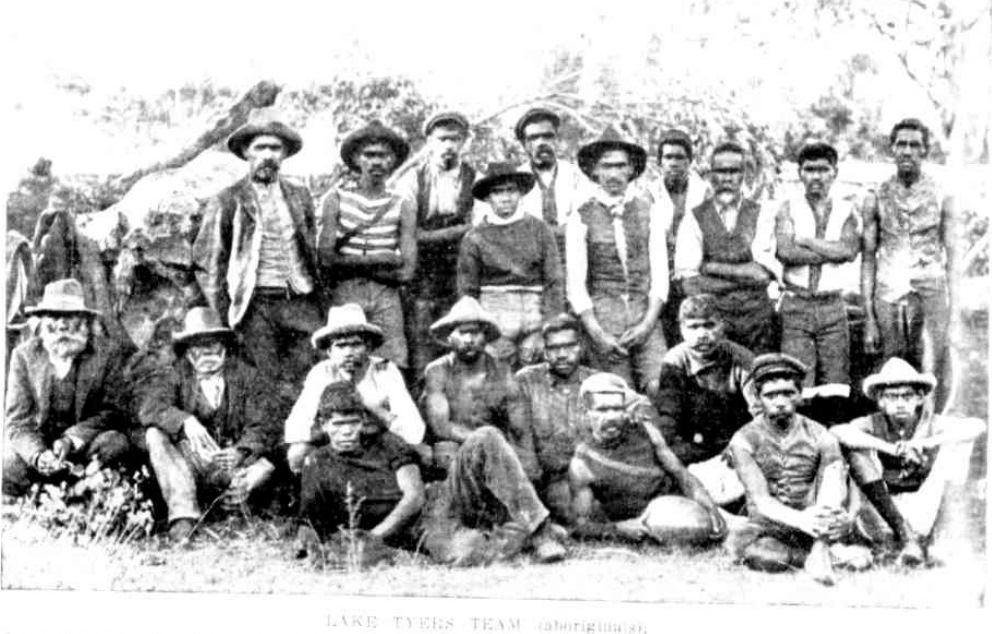
Lake Tyers Aboriginal Football Team, 1906. Source: The Weekly Times, July 21, 1906.
The match report for this game can be read here in The Snowy River Mail.
At the Bairnsdale Football Club Annual Meeting of 1907, the club acknowledged two matches from the previous year against Lake Tyers that “were remarkable for the evenness of the play and the thorough sportsmanlike conduct of both teams. Mention was made of the determination of Lake Tyers to fulfil their engagements faced with the necessity of walking eight miles from the mission station to Cuninghame on the mornings of the matches in order to catch the boat to Bairnsdale.”
A second photo of the Lake Tyers team was published in The Weekly Times on October 10, 1908, as one of the “Premier Teams” in “Town and Country.” The two photos make for a striking comparison. In the space of two years the team, with meagre resources at their disposal, were able to procure the light blue, gold sashed guernseys that were described in the match report five years later.
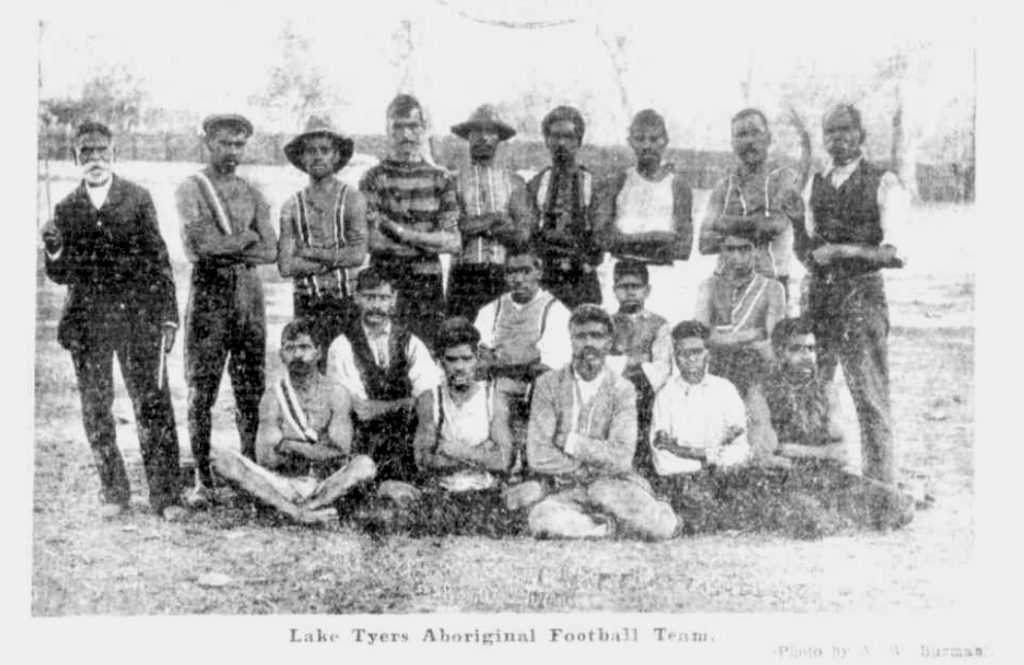
Lake Tyers Aboriginal Football Team, 1908. Source: The Weekly Times, October 10, 1908.
Unfortunately, we don’t have the names of the players in the photographs, but they must have made an impression to the people of Melbourne and, especially, T. Fleming Cooke of the Carlton Football Club. If not for him, this match against the “Premier Team” from Lake Tyers would not have taken place.
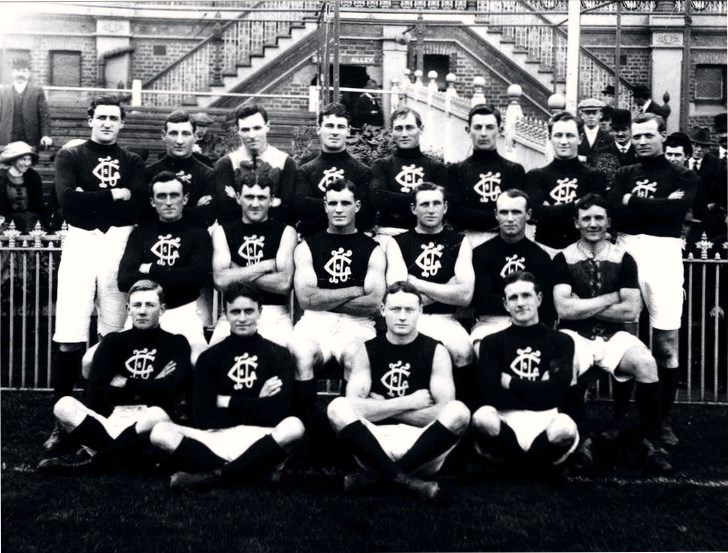
Carlton Football Club, 1913. Source: blueseum.org
If you consider the treatment Doug Nicholls received from Carlton 14 years later in 1927 when he was left out because of his Aboriginality then we can start to understand why this match and others were swept under the historical rug.
The colonial archive also offers a tantalising glimpse of a second match with a VFL team, namely Fitzroy, against Lake Tyers in the 1920s (most likely 1922). Hopefully, more details about this match will be unearthed in the future. It appears in 1929 in The Gippsland Times in a report about the exclusion of the Lake Tyers team from local competitions because of the colour of their skin and the refusal of the Aboriginal Protection Board to help overturn the injustice. “The fact was recalled that the Fitzroy team, when premiers, played a game for charity with the aborigines team at Bairnsdale. The Lake Tyers team held its own for the first half and won the respect of the Fitzroy men.”
In October 1924, in another forgotten match, Lake Tyers was “too strong for the Hawthorn Association 18.” The Sydney Sun published a photo of the president of Hawthorn, J.W. Kennon, presenting the captain of Lake Tyers, Charlie Green, with a football. In 1925, the VFA club joined the VFL.
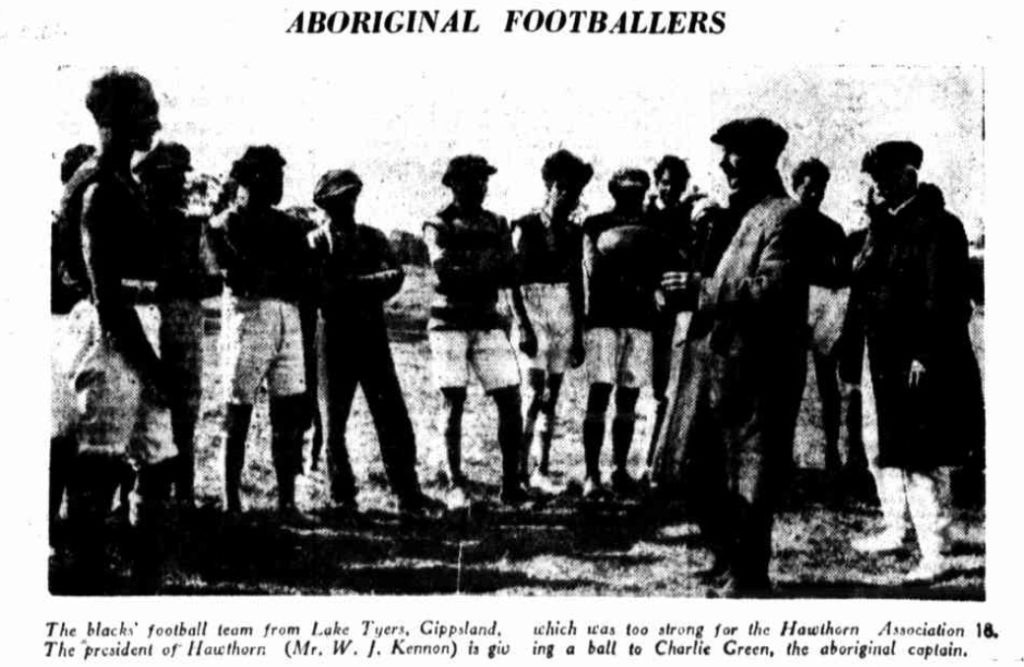
Source: The Sun (Sydney), November 4, 1924.
Again, as with the match against Carlton, the tour of the Hawthorn team to Gippsland was reported in The Argus, but of the match there was nothing else in Melbourne’s press.
The buzz created by Doug Nicholls with his dazzling performances for Northcote in the VFA and then Fitzroy had the effect of awakening the interest of other VFL clubs to long ignored, talented Aboriginal players. In 1935, South Melbourne and St. Kilda made requests for the Lake Tyers team to visit Melbourne only to come up against the cold, cruel heart of officialdom.
“Visit of Lake Tyers Team Cancelled” The Age reported. “St. Kilda club has received official advice that it is impossible for the Lake Tyers team of aborigines to play in one of the practice matches at St. Kilda next month against a St. Kilda side.”
The Record of Emerald Hill told a similar story, “It was the intention of Mr. ‘Bob’ Powell to arrange a match between South Melbourne and a team of aborigines from the Lake Tyers Settlement, until word was received that the Aborigines’ Board could not see its way clear to allow the dusky-colored footballers to visit Melbourne on that date. The appearance of the Australian natives, the majority of whom play barefooted, would have proved a great attraction.”
The prejudice and contempt shown towards Aboriginal football teams also extended to Melbourne’s football authorities. A request in 1936 from the Cummeragunja Aboriginal team for an exhibition match against the V.F.A. was rejected. According to The Argus, “Councillor T. Griffen (Port Melbourne) said that a match of this kind would make a burlesque of the Association, and it was decided to take no action in the matter.”
In 1944, the Melbourne public had the opportunity to watch an Aboriginal team in action. An enthusiastic holiday weekend crowd of 10,000 attended a charity match organised by Doug Nicholls between a combined Victorian – New South Wales Aboriginal team and Northcote. The Age reported “at one stage in the afternoon motor traffic outside the ground became so heavy that Northcote police could not cope with the situation and a patrol car was sent from Russell-street to assist.” The charity match against Northcote was repeated for two more years.
The second half of the 2oth century saw an explosion in the numbers of Indigenous players representing clubs in the VFL. This did not pass unnoticed by nastier elements in the crowds who subjected the players to torrents racial abuse. The VFL ignored the abuse, just like they had conveniently ignored the achievements of Indigenous teams and players.
The VFL became the AFL and then one memorable day in 1993 Nicky Winmar, sick and tired of the appalling racial vilification he had been subjected to from the crowd at Victoria Park, took matters into his own hands and drew a line in the sand.
In 1994, the AFL staged a match in Darwin between the “Aboriginal All- Stars” and Collingwood as an act of reconciliation. It had taken eighty years since Lake Tyers played Carlton in that forgotten match, and almost as many against Fitzroy, for another a VFL/AFL team to play an Indigenous team and for the AFL to begin the process of recognising Indigenous achievement and influence in “Australia’s Game.”
The AFL prides itself on its role in improving Australian race relations, but questions need to be asked about their reluctance to commemorate early Indigenous teams and players. Is it because the colonial record is too confronting for them to engage with
* Since the publication of this article, Carlton Football Club historian Tony De Bolfo contacted Shoot Farken. The story of this historic match can now be read on the Carlton FC website. It was accompanied by an invaluable archival photo of the club’s visit, they just did not realise the importance of it.
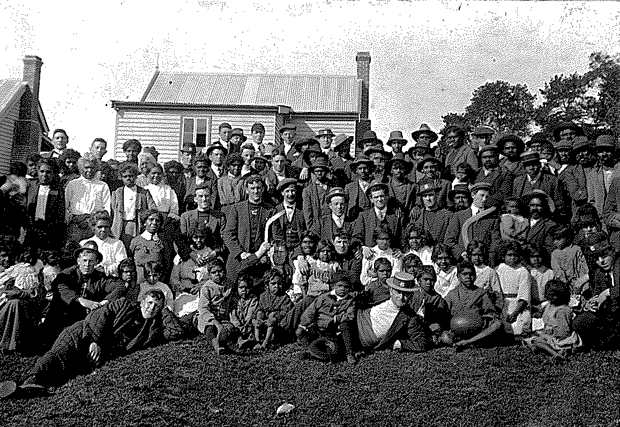
Players and officials of both Carlton and Lake Tyers Aboriginal Station football teams, together with local elders and children, 1913. (Photo: Carlton Media)
**Author’s Note: The first time the “Aboriginal All-Stars” appeared was in a match in 1983 against a combined Richmond VFL and Sunraysia Football Association team played in Mildura.
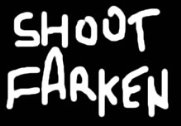
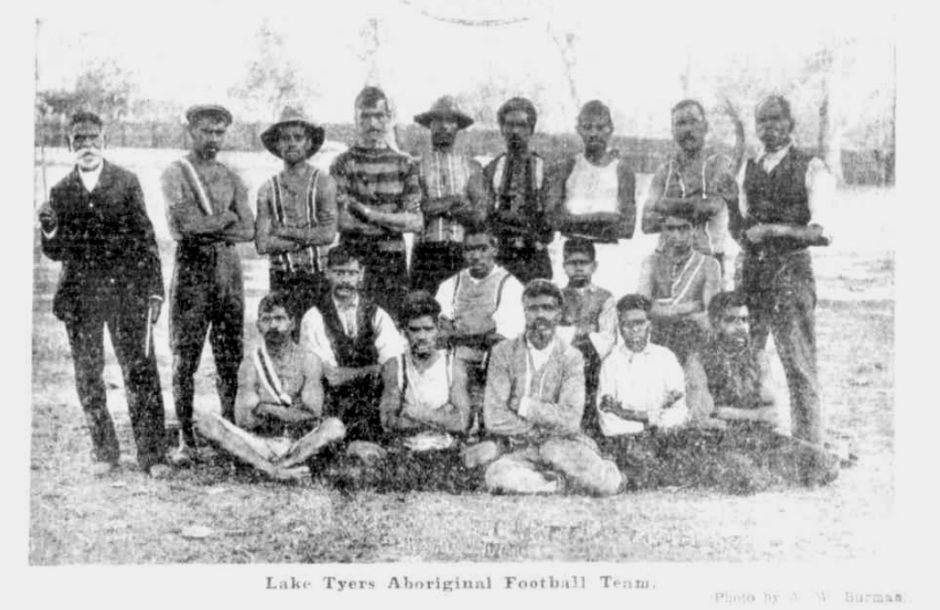

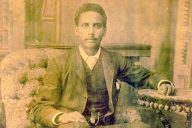
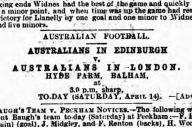
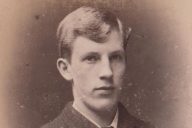











Great piece Athas, well researched and written.
Regarding the reference to Fitzroy: the Roys won the 1922 VFL Premiership so any game they played as premiers at Lake Tyers would have been either at the conclusion of the 1922 season or during the 1923 season.
Thanks Adam. Unfortunately, in Trove the Bairnsdale paper ends in 1918 and I am yet to find a reference to this game in the digital archive. Hopefully, one day, something will pop online or at a visit to the library.
When I get back to Oz will contact people I know in the Roys Historical Society to see what may be in their archives.
Hi Athas, great to see the coverage of your research in The Age. Along with Roy Hay, you’re making a terrific contribution.
Just a quick response to these two sentences:
“The AFL prides itself on its role in improving Australian race relations, but questions need to be asked about their reluctance to commemorate early Indigenous teams and players. Is it because the colonial record is too confronting for them to engage with?”
My guess is that the AFL has hardly any idea about its history. I suspect that its position is one of ignorance rather than denialism. Of course, if the AFL was prepared to provide research grants for people to work on the history of the game (and not just PR), people like you and Roy could actually be resourced to do much more.
Hi Daryl, yes, great to see the discovery of the historic match between Lake Tyers and Carlton get coverage in The Age today. http://www.theage.com.au/afl/afl-news/revealed-the-first-aussie-rules-match-between-a-vfl-side-and-an-aboriginal-side-20170526-gwe4wq.html Anthony Colangelo did a great job reporting it. The AFL is a very wealthy organisation, so questions do need to be asked. Why devote so few resources to history of the game? As custodians of Australian Rules football, being ignorant of the history of their own game is, you have to admit, an unsatisfactory state of affairs that needs rectifying.
i am currently working on a project that disputes your game, The first recorded Game of its Kind
I have one placed earlier between a Selected Aboriginal and Non-Aboriginal Side.
Hi Donna, by 1913 Indigenous teams like Framlingham, Cummeragunja, Coranderrk, Lake Tyers had played numerous games against white teams for decades in Victoria. I make reference to some important games in this article. I have also written about the Coranderrk and Cummeragunja teams on this website. I suggest you read them, there are links in this article. However, I have found no earlier record of an Indigenous team playing a VFL team. The VFL which then became the AFL started in 1897. If you have proof of a match played between a VFL team and an Indigenous team between 1897 and 1912 I would like to see it.